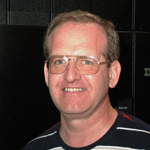|
|||||||||
|
|
Ian Foster and Carl Kesselman outlined Grid concepts in 1999 in their
book "The Grid Blueprint for a new Computing infrastructure". In a
subsequent paper, "the Anatomy of the Grid", the following
definition was proposed for Grid as "a Technology that provides
coordinated resource sharing and problem solving in dynamic,
multi-institutional virtual organizations". Looking further down in
actual Grid flavours we have the following functional taxonomy: Compute
Grid, Data Grid, Scavenging Grid, Aggregating Grid and Hybrid Grids. Brief Bio of Pierre Sablonière Pierre Sablonière is the Technical Director of the IBM
EMEA ATS Products & Solution Support Centre located in Montpellier,
France. In his current responsibilities, he overlooks all critical projects
and special initiatives occurring in the centre such as benchmarks and
porting projects. He is technically heading the IBM Grid Innovation Centre
opened in Montpellier late April 2002. Pierre Sablonière graduated from
Ecole Polytechnique, Paris and holds a postgraduate degree in IT from the
University of Montpellier. He is an IBM Senior Certified IT Specialist and a
member of the IBM Technical Expert Council for the EMEA West region.
Users often take replicas of their important data, for instance replicating mail folders and appointments from their PC to a handheld device. When information is updated the replicas become inconsistent. Our IceCube project aims to automate consistency in a general manner. To this goal, we designed what is in essence a scheduler that combines disconnected updates, from all applications, in a non-conflicting way, according to semantic constraints provided by applications. What started as blue-sky research has practical impact and has opened new theoretical avenues. Brief Bio of Marc Shapiro Dr. Shapiro graduated from ENSEEIHT, in Toulouse (France), in 1978, and received his Ph.D. from the Université Paul-Sabatier of Toulouse in 1980. After a post-doc at MIT, 1980--1982, he worked for the Centre Mondial Informatique et Ressources Humaines in Paris from 1982 to 1984. His collaboration with INRIA started in 1983; in 1985 he started the SOR group. He spent the 1993--1994 year on sabbatical at the Computer Science Department of Cornell University in Ithaca, NY (USA). He was the coordinator for the Esprit Long Term Research project PerDiS, a Persistent Distributed Store for Cooperative Engineering applications. He now leads the Cambridge Distributed Systems Group at Microsoft Research Ltd. in Cambridge (UK) since October 1998.
Copyright © Escola Superior de Tecnologia de Setúbal, Instituto Politécnico de Setúbal |
||||||||




